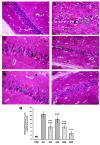Ameliorative Potential of (-) Pseudosemiglabrin in Mice with Pilocarpine-Induced Epilepsy: Antioxidant, Anti-Inflammatory, Anti-Apoptotic, and Neurotransmission Modulation
- PMID: 37445950
- PMCID: PMC10341902
- DOI: 10.3390/ijms241310773
Ameliorative Potential of (-) Pseudosemiglabrin in Mice with Pilocarpine-Induced Epilepsy: Antioxidant, Anti-Inflammatory, Anti-Apoptotic, and Neurotransmission Modulation
Abstract
One prevalent neurological disorder is epilepsy. Modulating GABAergic/glutamatergic neurotransmission, Nrf2/HO-1, PI3K/Akt, and TLR-4/NF-B pathways might be a therapeutic strategy for epilepsy. Eight-week-old BALB/c mice were administered 12.5, 25, or 50 mg/kg (-) pseudosemiglabrin orally one hour before inducing epilepsy with an i.p. injection of 360 mg/kg pilocarpine. (-) Pseudosemiglabrin dose-dependently alleviated pilocarpine-induced epilepsy, as revealed by the complete repression of pilocarpine-induced convulsions and 100% survival rate in mice. Furthermore, (-) pseudosemiglabrin significantly enhanced mice's locomotor activities, brain GABA, SLC1A2, GABARα1 levels, glutamate decarboxylase activity, and SLC1A2 and GABARα1mRNA expression while decreasing brain glutamate, SLC6A1, GRIN1 levels, GABA transaminase activity, and SLC6A1 and GRIN1 mRNA expression. These potentials can be due to the suppression of the TLR-4/NF-κB and the enhancement of the Nrf2/HO-1 and PI3K/Akt pathways, as demonstrated by the reduction in TLR-4, NF-κB, IL-1β, TNF-α mRNA expression, MDA, NO, caspase-3, Bax levels, and Bax/Bcl-2 ratio, and the enhancement of Nrf2, HO-1, PI3K, Akt mRNA expression, GSH, Bcl-2 levels, and SOD activity. Additionally, (-) pseudosemiglabrin abrogated the pilocarpine-induced histopathological changes. Interestingly, the (-) pseudosemiglabrin intervention showed a comparable effect to the standard medication, diazepam. Therefore, (-) pseudosemiglabrin can be a promising medication for the management of epilepsy.
Keywords: (-) pseudosemiglabrin; GABAergic and glutamatergic neurotransmission; Nrf2/HO-1 pathway; PI3K/Akt pathway; TLR-4/NF-κB pathway; epilepsy.
Conflict of interest statement
The authors declare no conflict of interest. Moreover, the funders had no role in the design of the study; in the collection, analysis, or interpretation of data; in the writing of the manuscript; or in the decision to publish the results.
Figures








Similar articles
-
Dynorphin activation of kappa opioid receptor protects against epilepsy and seizure-induced brain injury via PI3K/Akt/Nrf2/HO-1 pathway.Cell Cycle. 2019 Jan;18(2):226-237. doi: 10.1080/15384101.2018.1562286. Epub 2018 Dec 30. Cell Cycle. 2019. PMID: 30595095 Free PMC article.
-
Camel Milk Ameliorates 5-Fluorouracil-Induced Renal Injury in Rats: Targeting MAPKs, NF-κB and PI3K/Akt/eNOS Pathways.Cell Physiol Biochem. 2018;46(4):1628-1642. doi: 10.1159/000489210. Epub 2018 Apr 20. Cell Physiol Biochem. 2018. PMID: 29694984
-
Matrine alleviates early brain injury after experimental subarachnoid hemorrhage in rats: possible involvement of PI3K/Akt-mediated NF-κB inhibition and Keap1/Nrf2-dependent HO-1 inductionn.Cell Mol Biol (Noisy-le-grand). 2016 Sep 30;62(11):38-44. Cell Mol Biol (Noisy-le-grand). 2016. PMID: 27755950
-
Mycophenolate mofetil attenuates concanavalin A-induced acute liver injury through modulation of TLR4/NF-κB and Nrf2/HO-1 pathways.Pharmacol Rep. 2020 Aug;72(4):945-955. doi: 10.1007/s43440-019-00055-4. Epub 2020 Jan 14. Pharmacol Rep. 2020. PMID: 32048261
-
Flavonoids as therapeutic agents for epilepsy: unveiling anti-inflammatory and antioxidant pathways for novel treatments.Front Pharmacol. 2024 Sep 12;15:1457284. doi: 10.3389/fphar.2024.1457284. eCollection 2024. Front Pharmacol. 2024. PMID: 39329119 Free PMC article. Review.
Cited by
-
Tephrosia purpurea, with (-)-Pseudosemiglabrin as the Major Constituent, Alleviates Severe Acute Pancreatitis-Mediated Acute Lung Injury by Modulating HMGB1 and IL-22.Int J Mol Sci. 2025 Mar 13;26(6):2572. doi: 10.3390/ijms26062572. Int J Mol Sci. 2025. PMID: 40141214 Free PMC article.
-
Insights into therapeutic approaches for the treatment of neurodegenerative diseases targeting metabolic syndrome.Mol Biol Rep. 2025 Feb 21;52(1):260. doi: 10.1007/s11033-025-10346-0. Mol Biol Rep. 2025. PMID: 39982557 Review.
-
Phytotherapeutic options for the treatment of epilepsy: pharmacology, targets, and mechanism of action.Front Pharmacol. 2024 May 24;15:1403232. doi: 10.3389/fphar.2024.1403232. eCollection 2024. Front Pharmacol. 2024. PMID: 38855752 Free PMC article. Review.
References
-
- WHO New WHO Brief Sets out Actions Needed to Improve Lives of People with Epilepsy. [(accessed on 5 January 2023)]; Available online: https://www.who.int/news/item/12-12-2022-new-who-brief-sets-out-actions-....
-
- Simonato M., Löscher W., Cole A.J., Dudek F.E., Engel J., Jr., Kaminski R.M., Loeb J.A., Scharfman H., Staley K.J., Velíšek L. Finding a better drug for epilepsy: Preclinical screening strategies and experimental trial design. Epilepsia. 2012;53:1860–1867. doi: 10.1111/j.1528-1167.2012.03541.x. - DOI - PMC - PubMed
MeSH terms
Substances
Grants and funding
LinkOut - more resources
Full Text Sources
Medical
Research Materials

